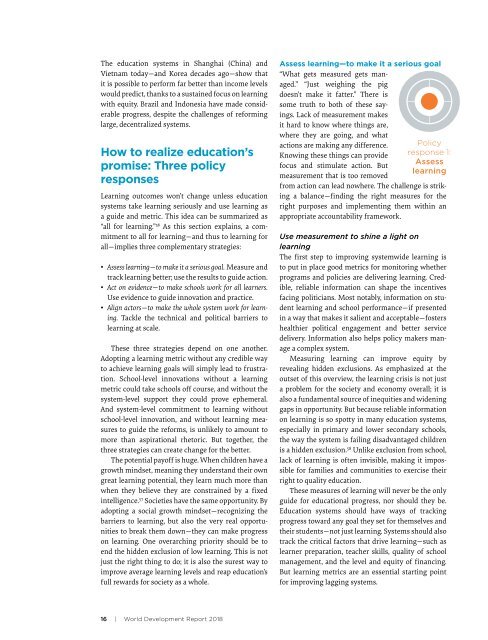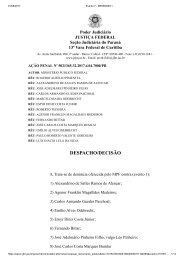Brasil só deve dominar Leitura em 260 anos, aponta estudo do Banco Mundial Relatorio Banco Mundial _Learning
You also want an ePaper? Increase the reach of your titles
YUMPU automatically turns print PDFs into web optimized ePapers that Google loves.
The education syst<strong>em</strong>s in Shanghai (China) and<br />
Vietnam today—and Korea decades ago—show that<br />
it is possible to perform far better than income levels<br />
would predict, thanks to a sustained focus on learning<br />
with equity. Brazil and In<strong>do</strong>nesia have made considerable<br />
progress, despite the challenges of reforming<br />
large, decentralized syst<strong>em</strong>s.<br />
How to realize education’s<br />
promise: Three policy<br />
responses<br />
<strong>Learning</strong> outcomes won’t change unless education<br />
syst<strong>em</strong>s take learning seriously and use learning as<br />
a guide and metric. This idea can be summarized as<br />
“all for learning.” 56 As this section explains, a commitment<br />
to all for learning—and thus to learning for<br />
all—implies three compl<strong>em</strong>entary strategies:<br />
• Assess learning—to make it a serious goal. Measure and<br />
track learning better; use the results to guide action.<br />
• Act on evidence—to make schools work for all learners.<br />
Use evidence to guide innovation and practice.<br />
• Align actors—to make the whole syst<strong>em</strong> work for learning.<br />
Tackle the technical and political barriers to<br />
learning at scale.<br />
These three strategies depend on one another.<br />
A<strong>do</strong>pting a learning metric without any credible way<br />
to achieve learning goals will simply lead to frustration.<br />
School-level innovations without a learning<br />
metric could take schools off course, and without the<br />
syst<strong>em</strong>-level support they could prove eph<strong>em</strong>eral.<br />
And syst<strong>em</strong>-level commitment to learning without<br />
school-level innovation, and without learning measures<br />
to guide the reforms, is unlikely to amount to<br />
more than aspirational rhetoric. But together, the<br />
three strategies can create change for the better.<br />
The potential payoff is huge. When children have a<br />
growth mindset, meaning they understand their own<br />
great learning potential, they learn much more than<br />
when they believe they are constrained by a fixed<br />
intelligence. 57 Societies have the same opportunity. By<br />
a<strong>do</strong>pting a social growth mindset—recognizing the<br />
barriers to learning, but also the very real opportunities<br />
to break th<strong>em</strong> <strong>do</strong>wn—they can make progress<br />
on learning. One overarching priority should be to<br />
end the hidden exclusion of low learning. This is not<br />
just the right thing to <strong>do</strong>; it is also the surest way to<br />
improve average learning levels and reap education’s<br />
full rewards for society as a whole.<br />
Assess learning—to make it a serious goal<br />
“What gets measured gets managed.”<br />
“Just weighing the pig<br />
<strong>do</strong>esn’t make it fatter.” There is<br />
some truth to both of these sayings.<br />
Lack of measur<strong>em</strong>ent makes<br />
it hard to know where things are,<br />
where they are going, and what<br />
actions are making any difference.<br />
Knowing these things can provide<br />
focus and stimulate action. But<br />
measur<strong>em</strong>ent that is too r<strong>em</strong>oved<br />
Policy<br />
response 1:<br />
Assess<br />
learning<br />
from action can lead nowhere. The challenge is striking<br />
a balance—finding the right measures for the<br />
right purposes and impl<strong>em</strong>enting th<strong>em</strong> within an<br />
appropriate accountability framework.<br />
Use measur<strong>em</strong>ent to shine a light on<br />
learning<br />
The first step to improving syst<strong>em</strong>wide learning is<br />
to put in place good metrics for monitoring whether<br />
programs and policies are delivering learning. Credible,<br />
reliable information can shape the incentives<br />
facing politicians. Most notably, information on student<br />
learning and school performance—if presented<br />
in a way that makes it salient and acceptable—fosters<br />
healthier political engag<strong>em</strong>ent and better service<br />
delivery. Information also helps policy makers manage<br />
a complex syst<strong>em</strong>.<br />
Measuring learning can improve equity by<br />
revealing hidden exclusions. As <strong>em</strong>phasized at the<br />
outset of this overview, the learning crisis is not just<br />
a probl<strong>em</strong> for the society and economy overall; it is<br />
also a fundamental source of inequities and widening<br />
gaps in opportunity. But because reliable information<br />
on learning is so spotty in many education syst<strong>em</strong>s,<br />
especially in primary and lower secondary schools,<br />
the way the syst<strong>em</strong> is failing disadvantaged children<br />
is a hidden exclusion. 58 Unlike exclusion from school,<br />
lack of learning is often invisible, making it impossible<br />
for families and communities to exercise their<br />
right to quality education.<br />
These measures of learning will never be the only<br />
guide for educational progress, nor should they be.<br />
Education syst<strong>em</strong>s should have ways of tracking<br />
progress toward any goal they set for th<strong>em</strong>selves and<br />
their students—not just learning. Syst<strong>em</strong>s should also<br />
track the critical factors that drive learning—such as<br />
learner preparation, teacher skills, quality of school<br />
manag<strong>em</strong>ent, and the level and equity of financing.<br />
But learning metrics are an essential starting point<br />
for improving lagging syst<strong>em</strong>s.<br />
16 | World Development Report 2018








